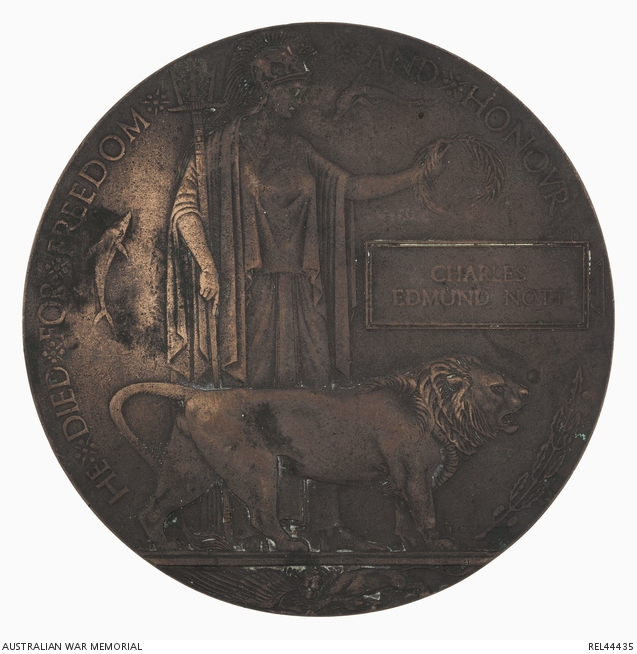| Place | Europe: France, Picardie, Somme, Amiens Harbonnieres Area, Villers-Bretonneux Area, Villers-Bretonneux |
|---|---|
| Accession Number | REL44435 |
| Collection type | Heraldry |
| Object type | Heraldry |
| Physical description | Bronze |
| Maker |
Royal Arsenal Woolwich |
| Place made | United Kingdom |
| Date made | 1922 |
| Conflict |
First World War, 1914-1918 |
Next of Kin Plaque : Private Charles Edmund Nott, 45 Battalion, AIF

Bronze next of kin plaque, showing on the obverse, Britannia holding a laurel wreath, the British lion, dolphins, a spray of oak leaves and the words 'HE DIED FOR FREEDOM AND HONOUR' around the edge. Beneath the main figures, the British lion defeats the German eagle. The initials 'ECP', for the designer Edward Carter Preston appear above the lion's right forepaw. A raised rectangle above the lion's head bears the name 'CHARLES EDMUND NOTT'.
Charles Edmund Nott was born at 'Mount Pleasant', Dunedoo, NSW around 1888. He was a farmer when he enlisted in the AIF on 21 February 1916. After initial training he was assigned as a private, service number 1972, to the 3rd reinforcements for the 45th Battalion. He sailed for England from Sydney aboard the troopship HMAT Warilda on 22 April and arrived at Plymouth on 18 July.
Nott was placed with the 12th Training Battalion at Rolleston the day after arriving, staying with the unit until he embarked for France on 16 September. He joined 45 Battalion near Ypres, a relatively quiet sector, on 22 September. During October the battalion was mainly involved in patrolling and occasional raids on enemy trenches before moving further north to the battlefields of the Somme.
The battalion took over the front lines near Guedecourt on 18 November. By now winter had made life in the trenches extremely difficult. Mud, frost, snow and water pervaded the entire system. Exhausted forward units were relieved every 48 hours. Movement on both sides was severely restricted with most activity being centred around the continual drainage and restoration of failing trenches and support lines. The artillery, however, still inflicted casualties on the opposing armies.
On 23 November the troops were busy cleaning the area around the support trenches, and 'bodies which were found in the open were buried'. Of the thirteen casualties suffered by the battalion through enemy shelling that day, eleven were wounded while one officer and Nott were killed.
It is not known whether Nott's remains were found but he has no known grave. His name is commemorated on the Villers-Bretonneux Memorial.
This commemorative plaque was sent to his parents, James and Elizabeth Nott, in 1922